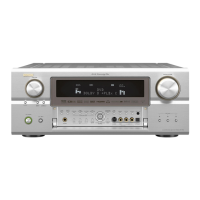ENGLISH
ENGLISH
Easy Setup and Operation Easy Setup and Operation
10
4
If the check ends, press the ENTER
button again.
3
Check the results of the speaker
detection, then press the
ENTER button.
• Switch to the second screen.
[ Second screen ]
NOTE:
• If the results are not as expected or if an error
message is displayed, select “Retry” and
perform the measurements again. (For details on
the error messages ( page 11).)
If the results of remeasurement are still not as
expected or if an error message is displayed, turn
off the power switch and check the speaker
connections. Then start the measurements again
from the beginning.
• Measurement is cancelled when MASTER
VOLUME is operated while the Auto Setup is
performed.
Speaker system measurement
With these measurements, the “Speaker
Configuration”, “Delay Time”, “Channel Level”,
“Crossover Frequency” and “Room EQ” are analyzed
automatically. The main listening position is measured
first, so leave the microphone where it is.
1
Press the CURSOR
DD
or
HH
button to
select the “OK Start”, then press the
CURSOR
FF
button.
• Measurements for the first point start.
The screen shown at the below appears once the
measurements for the main listening position are
completed.
2
Next the measurements for the second
point will be taken.
3
Press the CURSOR
FF
button.
• Measurements for the second point start.
Place the microphone at the second listening
position. For instructions on the position in which
the microphone should be placed ( page 8).
4
Perform step 2, 3 repeatedly.
5
After measuring at the number of
points according to your listening
environment, press the
CURSOR
DD
or
HH
button to select the “Calculate”, then
press the
CURSOR
FF
button.
• The speaker system is analyzed.
The amount of time required for the analysis
depends on the number of speakers and the
number of measuring points. The greater the
number of speakers and measuring points, the
longer the time required. For example, for ten
speaker systems and 6 measuring points, the
calculations require approximately 6 minutes.
Measurements can be ended when there are 5
or less measurement locations; however, to
obtain better results, measurements at 6 or
more locations is recommended.
Once the calculations are completed, a screen
for confirming the results of the measurements
appears.
The more measurement points, the better the
resulting room correction effect. We recommend
a minimum of 6 measurement points – 8
measurement points provides the best room
correction effect.

